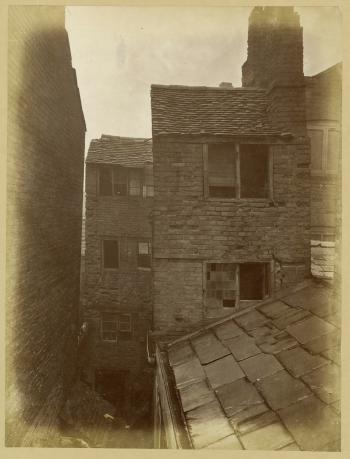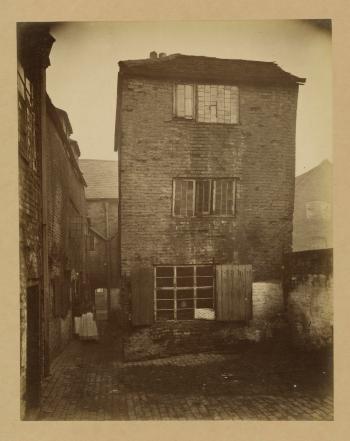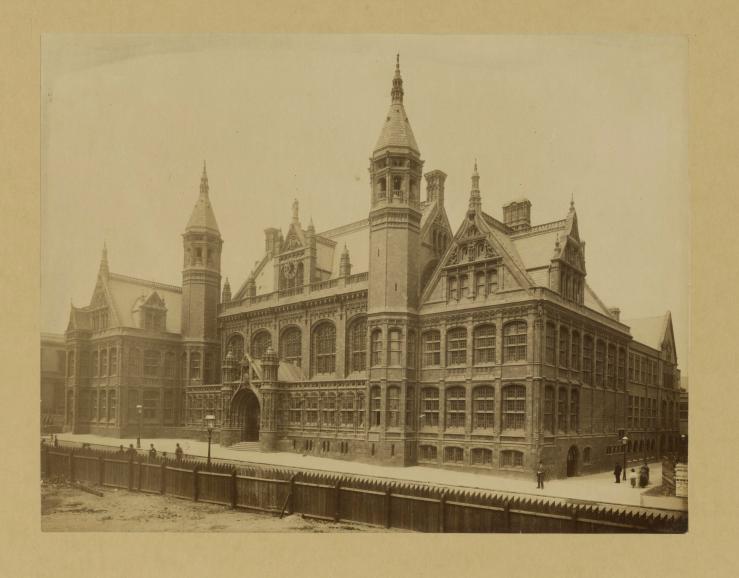This week marks the 100th anniversary of the death of Joseph Chamberlain, one of the most influential figures in the history of Birmingham. In commemoration, Newman University College and the Library of Birmingham will be hosting the Chamberlain International Centenary Conference on 4th and 5th July 2014, and further events will follow at the Library of Birmingham.
By 1875 Joseph Chamberlain, as Mayor of Birmingham, turned his attention to the removal of slums from the city centre and the creation ‘of a street as broad as a Parisian boulevard from New Street to Aston Road’, later named Corporation Street.

Print 31
The Artisans and Labourers’ Dwellings Improvement Act, 1875, had been passed by Parliament after considerable intervention by Chamberlain and leaders of other large towns, to enable the demolition of areas of slum housing and overcrowded courts, make landlords improve their housing stock and hence improve the health and welfare of citizens.

The Improvement Committee was appointed by Birmingham Council in July 1875 to receive reports from the Medical Officer of Health on insanitary conditions within the Borough, to prepare schemes for the improvement of such areas with estimates of cost, and to carry out the provisions of the Act which also gave local authorities the right of compulsory purchase and demolition.
The Improvement Committee minutes [BCC 1/AX/1/1-10, 1875 – 1899] chart the purchase of properties, both domestic and commercial, to enable the planning of new roads such as Corporation Street and new public buildings such as the Victoria Law Courts. Included in the minutes, which have indexes [BCC 1 AX/1/2/1-2], are printed versions of parliamentary legislation relating to the Birmingham Improvement Scheme, financial information and accounts, schedules of works, leases, property and rentals, progress reports, and observations of municipal officials on the areas near what would become Corporation Street. The minutes relating to the surveys of John Street undertaken during January 1879 by Councillor William Cook contain interesting details on the condition of many of the back to back houses and courts in that area. They show the processes by which the Corporation identified and bought insanitary or dilapidated properties for demolition and the impact this had on tenants, property owners and the local economy. There is also a printed report on the development of Corporation Street, 3 April 1881.

Print 132
There was also an Improvement Sub-Committee [BCC 1 /AX/2/1/1-6, 1875 – 1899] whose main function was to confer with the architects, the Birmingham-based architectural practice of Martin and Chamberlain. These minutes include reports on the renovation or demolition of existing properties and the construction of new ones, particularly the Victoria Law Courts. They also give details of compensation cases of individual businessmen (particularly public house landlords and shopkeepers) and tenants of houses owned by the Corporation who faced eviction from their property.

Print 34
There are a number of plans of the Improvement Scheme areas drawn up by Martin and Chamberlain which show the intended redevelopment [e.g. LS 504/1-2 (1875)] and there is a further wonderful visual accompaniment in the collection of 134 Improvement Scheme photographs taken by James Burgoyne, a photographer from Small Heath, which date from 1876 – 1885 and show the conditions of the main streets which were redeveloped [LS 2/1-134]. The images seen here are all from this collection.
The minutes, maps and photographs are all available to consult in the Wolfson Centre for Archival Research, Archives, Heritage and Photography at the Library of Birmingham by appointment.
The new edition of the History West Midlands Magazine is also dedicated to Chamberlain and you can subscribe through their website at http://historywm.com/ for access to a fascinating insight into his life and career.
Fiona Tait

[…] and population tilted towards the north. The political clout of the great northern cities and the golden age of Victorian municipalism was a result of this industrial power, not the cause of […]